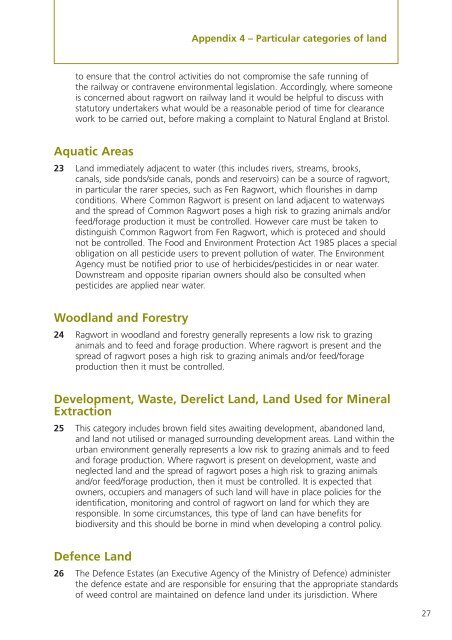code of practice on hopw to prevent the spread of ragwort - Defra
code of practice on hopw to prevent the spread of ragwort - Defra
code of practice on hopw to prevent the spread of ragwort - Defra
You also want an ePaper? Increase the reach of your titles
YUMPU automatically turns print PDFs into web optimized ePapers that Google loves.
<strong>to</strong> ensure that <strong>the</strong> c<strong>on</strong>trol activities do not compromise <strong>the</strong> safe running <str<strong>on</strong>g>of</str<strong>on</strong>g><br />
<strong>the</strong> railway or c<strong>on</strong>travene envir<strong>on</strong>mental legislati<strong>on</strong>. Accordingly, where some<strong>on</strong>e<br />
is c<strong>on</strong>cerned about <strong>ragwort</strong> <strong>on</strong> railway land it would be helpful <strong>to</strong> discuss with<br />
statu<strong>to</strong>ry undertakers what would be a reas<strong>on</strong>able period <str<strong>on</strong>g>of</str<strong>on</strong>g> time for clearance<br />
work <strong>to</strong> be carried out, before making a complaint <strong>to</strong> Natural England at Bris<strong>to</strong>l.<br />
Aquatic Areas<br />
23 Land immediately adjacent <strong>to</strong> water (this includes rivers, streams, brooks,<br />
canals, side p<strong>on</strong>ds/side canals, p<strong>on</strong>ds and reservoirs) can be a source <str<strong>on</strong>g>of</str<strong>on</strong>g> <strong>ragwort</strong>,<br />
in particular <strong>the</strong> rarer species, such as Fen Ragwort, which flourishes in damp<br />
c<strong>on</strong>diti<strong>on</strong>s. Where Comm<strong>on</strong> Ragwort is present <strong>on</strong> land adjacent <strong>to</strong> waterways<br />
and <strong>the</strong> <strong>spread</strong> <str<strong>on</strong>g>of</str<strong>on</strong>g> Comm<strong>on</strong> Ragwort poses a high risk <strong>to</strong> grazing animals and/or<br />
feed/forage producti<strong>on</strong> it must be c<strong>on</strong>trolled. However care must be taken <strong>to</strong><br />
distinguish Comm<strong>on</strong> Ragwort from Fen Ragwort, which is proteced and should<br />
not be c<strong>on</strong>trolled. The Food and Envir<strong>on</strong>ment Protecti<strong>on</strong> Act 1985 places a special<br />
obligati<strong>on</strong> <strong>on</strong> all pesticide users <strong>to</strong> <strong>prevent</strong> polluti<strong>on</strong> <str<strong>on</strong>g>of</str<strong>on</strong>g> water. The Envir<strong>on</strong>ment<br />
Agency must be notified prior <strong>to</strong> use <str<strong>on</strong>g>of</str<strong>on</strong>g> herbicides/pesticides in or near water.<br />
Downstream and opposite riparian owners should also be c<strong>on</strong>sulted when<br />
pesticides are applied near water.<br />
Woodland and Forestry<br />
24 Ragwort in woodland and forestry generally represents a low risk <strong>to</strong> grazing<br />
animals and <strong>to</strong> feed and forage producti<strong>on</strong>. Where <strong>ragwort</strong> is present and <strong>the</strong><br />
<strong>spread</strong> <str<strong>on</strong>g>of</str<strong>on</strong>g> <strong>ragwort</strong> poses a high risk <strong>to</strong> grazing animals and/or feed/forage<br />
producti<strong>on</strong> <strong>the</strong>n it must be c<strong>on</strong>trolled.<br />
Development, Waste, Derelict Land, Land Used for Mineral<br />
Extracti<strong>on</strong><br />
25 This category includes brown field sites awaiting development, aband<strong>on</strong>ed land,<br />
and land not utilised or managed surrounding development areas. Land within <strong>the</strong><br />
urban envir<strong>on</strong>ment generally represents a low risk <strong>to</strong> grazing animals and <strong>to</strong> feed<br />
and forage producti<strong>on</strong>. Where <strong>ragwort</strong> is present <strong>on</strong> development, waste and<br />
neglected land and <strong>the</strong> <strong>spread</strong> <str<strong>on</strong>g>of</str<strong>on</strong>g> <strong>ragwort</strong> poses a high risk <strong>to</strong> grazing animals<br />
and/or feed/forage producti<strong>on</strong>, <strong>the</strong>n it must be c<strong>on</strong>trolled. It is expected that<br />
owners, occupiers and managers <str<strong>on</strong>g>of</str<strong>on</strong>g> such land will have in place policies for <strong>the</strong><br />
identificati<strong>on</strong>, m<strong>on</strong>i<strong>to</strong>ring and c<strong>on</strong>trol <str<strong>on</strong>g>of</str<strong>on</strong>g> <strong>ragwort</strong> <strong>on</strong> land for which <strong>the</strong>y are<br />
resp<strong>on</strong>sible. In some circumstances, this type <str<strong>on</strong>g>of</str<strong>on</strong>g> land can have benefits for<br />
biodiversity and this should be borne in mind when developing a c<strong>on</strong>trol policy.<br />
Defence Land<br />
Appendix 4 – Particular categories <str<strong>on</strong>g>of</str<strong>on</strong>g> land<br />
26 The Defence Estates (an Executive Agency <str<strong>on</strong>g>of</str<strong>on</strong>g> <strong>the</strong> Ministry <str<strong>on</strong>g>of</str<strong>on</strong>g> Defence) administer<br />
<strong>the</strong> defence estate and are resp<strong>on</strong>sible for ensuring that <strong>the</strong> appropriate standards<br />
<str<strong>on</strong>g>of</str<strong>on</strong>g> weed c<strong>on</strong>trol are maintained <strong>on</strong> defence land under its jurisdicti<strong>on</strong>. Where<br />
27
















